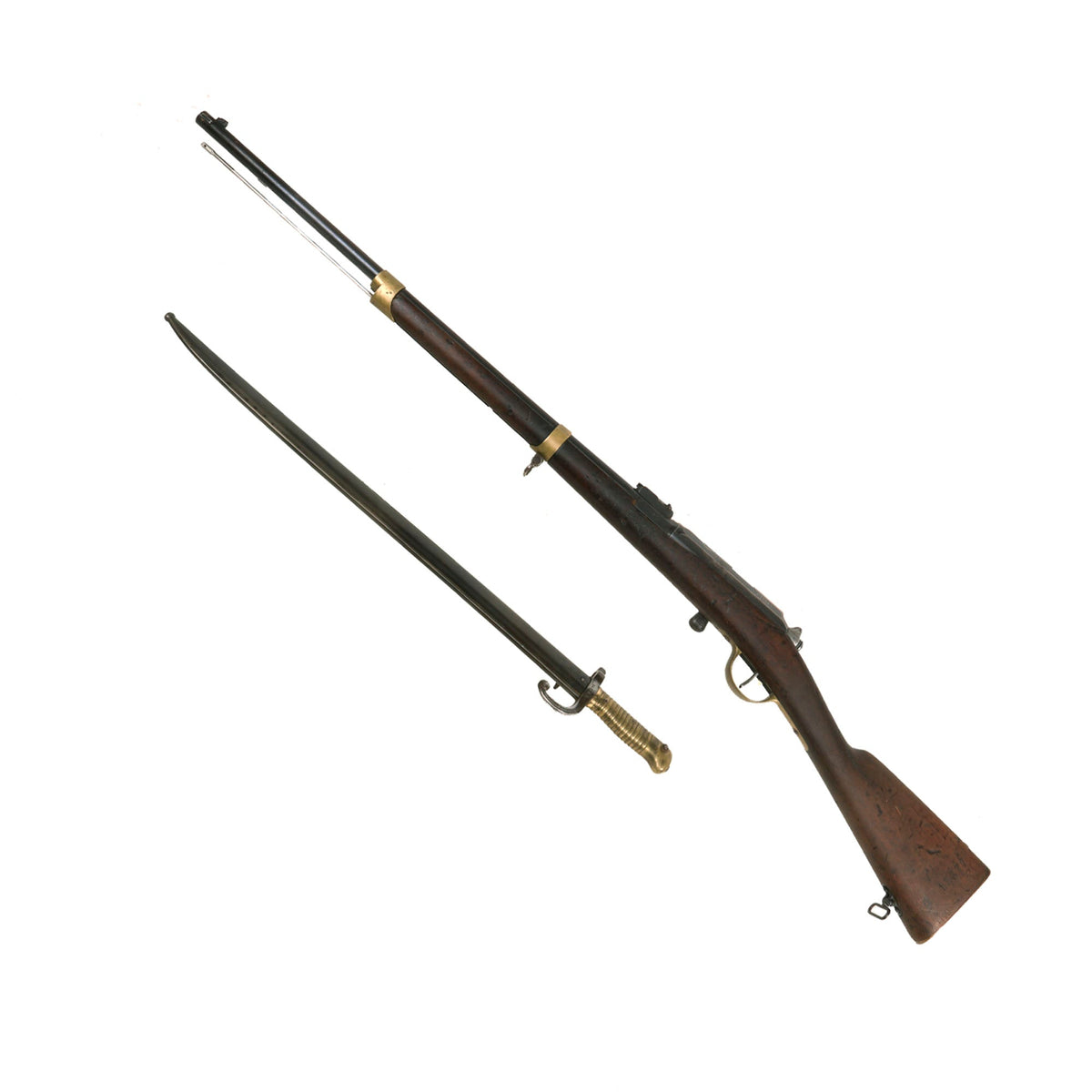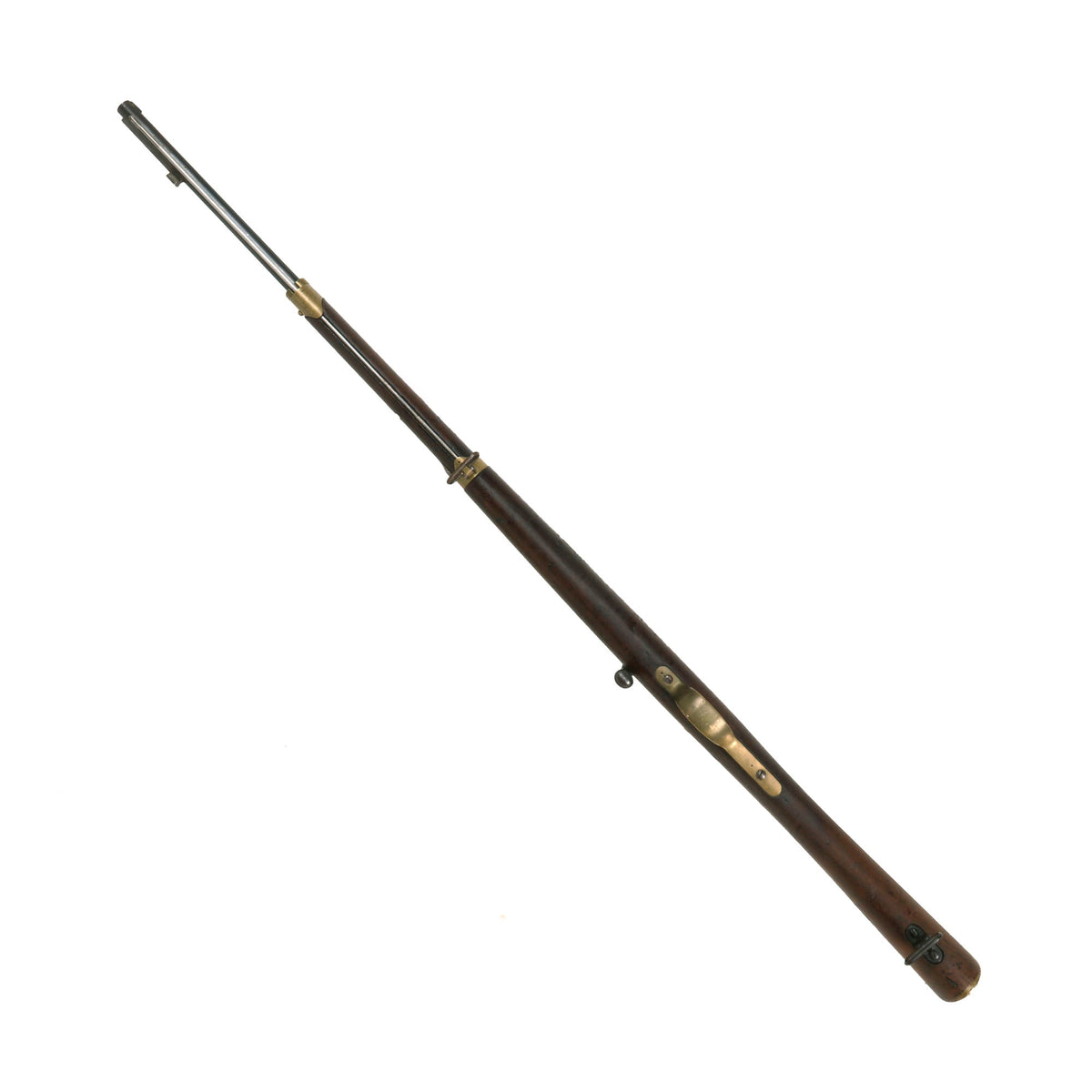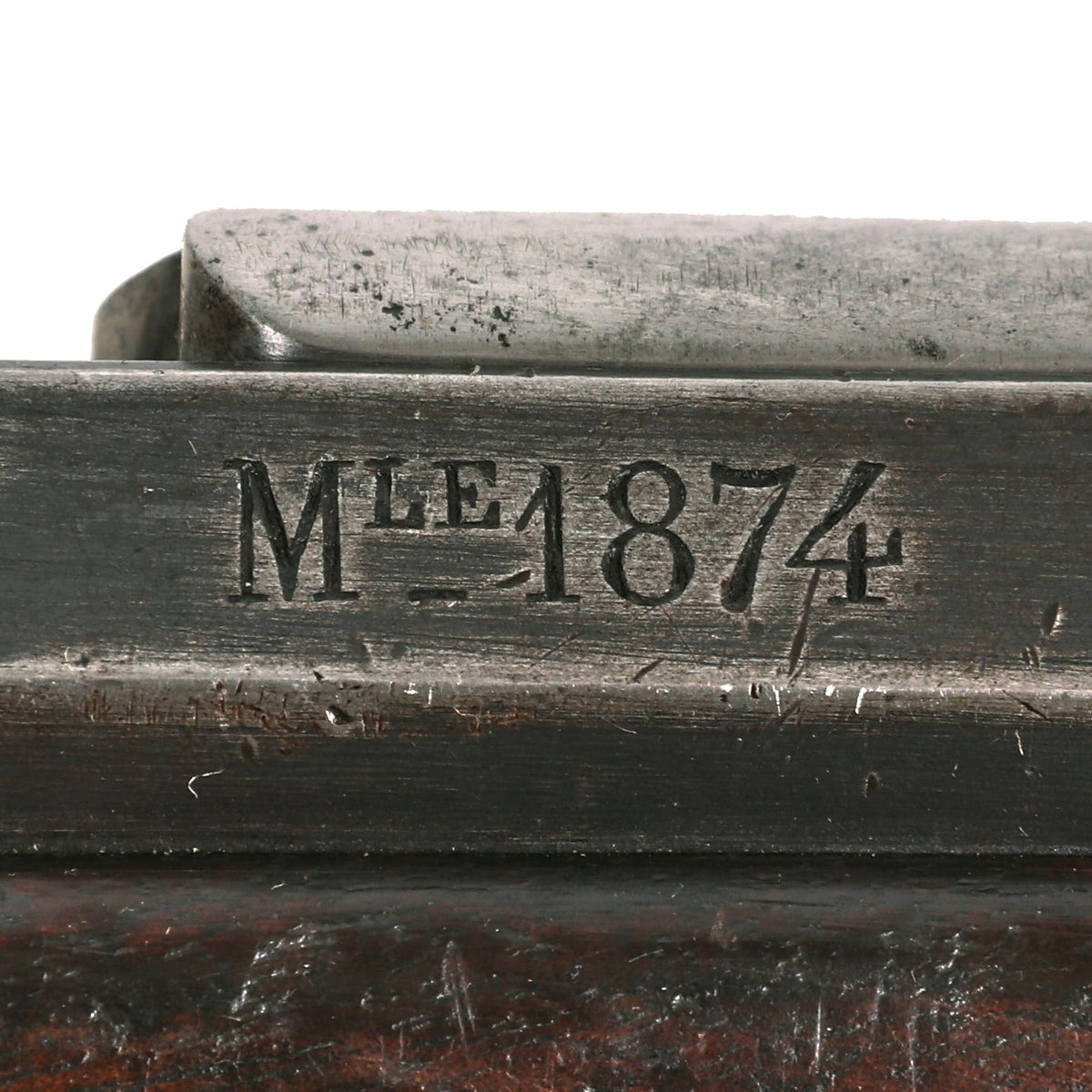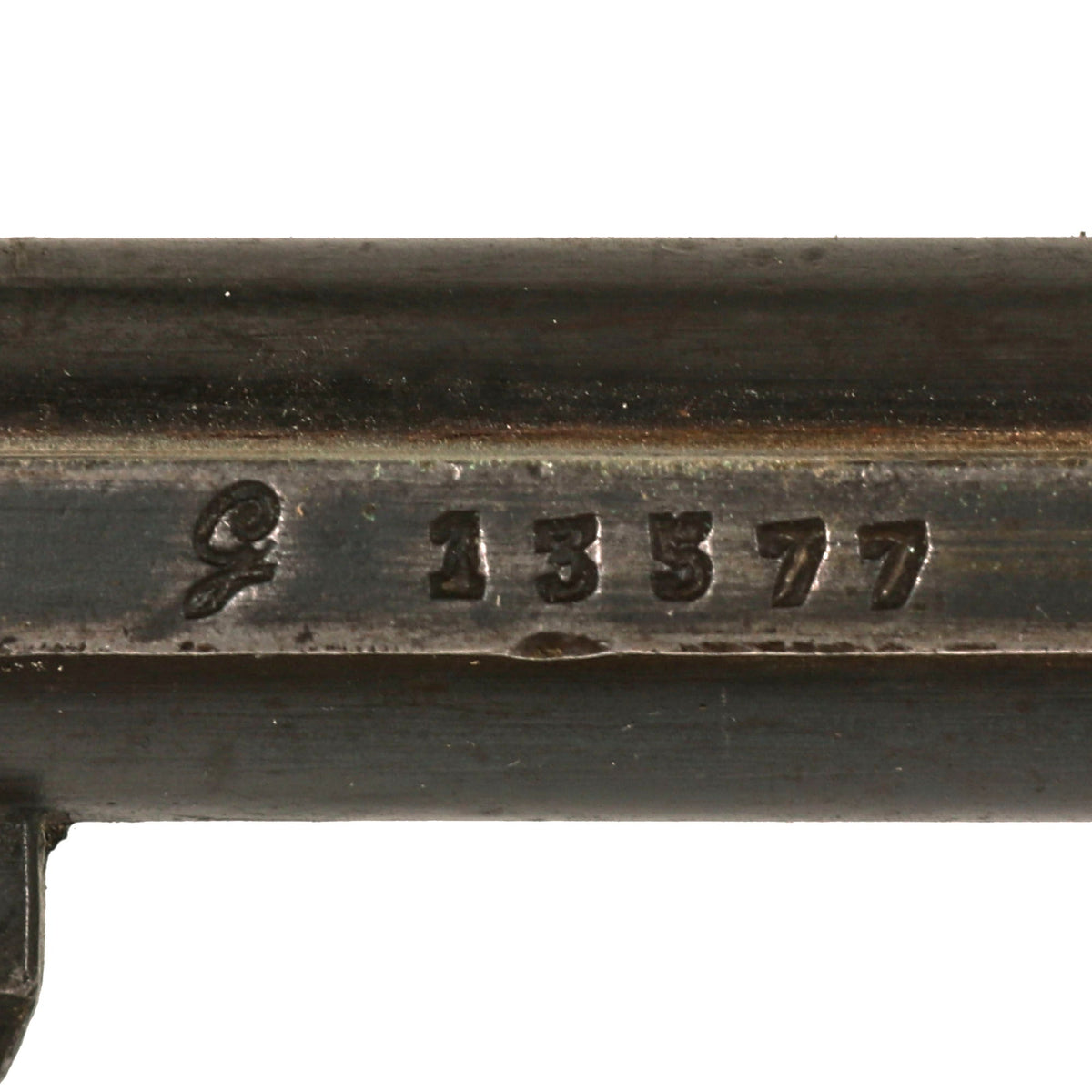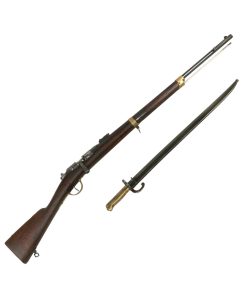Original French MLE 1874 M80 Brass Mounted Gras Camel Short Rifle by St. Étienne dated 1883 with M1866 Sabre Bayonet Original Items
$ 1.195,00 $ 298,75
Original Item: Only One Available. This lovely little brass mounted CAMEL SHORT RIFLE / CARBINE was issued for “Colonial Service”, as indicated by the brass mounts, and was originally produced as a MLE1874 “Gras” rifle, and later shortened for colonial service. Included is a MLE1866 Long Saber Bayonet & Scabbard, originally made for the Chassepot Needle-fire rifle.
The left side of the receiver marked MANUFACTURE D’ARMES / St. Étienne / M80 next to Mle 1874 indicating manufacture at the government arsenal at St. Étienne. The “M.80” is for a later update to the action that added a channel for gas escape to the bolt and receiver, in the case of a ruptured primer. The rifle has arsenal proofs on most parts, and also is marked S.1883, indicating original manufacture in 1883 (S Is the St. Étienne Prefix). The short rifle retains its serial number of G 13577 on the barrel, bayonet lug, and stock. French rifles of this era generally did not have the receiver marked with a visible serial. The bolt, which has its correct mounted troop’s “turn down” bolt handle, is numbered F 24838, with a non-matching bolt head. This bolt modification helped prevent the rifle snagging on the horses tack. The weapon still retains the bayonet stand, which were usually removed, and does have its correct “short” adjustable rear sight still in place.
Overall condition of this short rifle is good, with the metalwork still bearing the original markings well, and now showing any major oxidation or other damage from wear. The finish is worn a bit on the barrel towards plum, but overall it is quite nice for one of these Camel Rifles.
The bore is in excellent condition, showing a bright finish with crisp lands and grooves. It shows very little evidence of ever having been fired, which may be why they elected not to cut it down like they usually would. The stock is in good shape, but definitely shows wear and damage from use, particularly on the left side near the receiver. There is a large chunk of wood missing along the woodline beneath the sight. and also a crack right by the rear receiver. The stock has the expected dents, scratches, and chips as expected of a weapon that was in service for decades.
Included with this rifle a correct issue Yataghan-Bladed Model M1866 Chassepot sword bayonet, complete with scabbard. This bayonet is in good condition, with a nice blade with a peppery patina of age. The crossguard is marked with an “Anchor” indicating colonial issue. This looks to be a bayonet made under contract by Germany, as it has a Königskopf (King’s Head) on the blade ricasso, the logo of Gebrüder Weyersberg, Waffenfabrik, and later Weyersberg Kirschbaum after their 1883 merger with W.R. Kirschbaum.
Remember GARY COOPER in “BEAU GESTE” about the French Foreign Legion? In really good condition, fully cleaned and ready to display, all you need is a Camel!
Specifications (carbine):-
Year of Manufacture: 1880 – converted later
Caliber: 11×59mmR Gras
Cartridge Type: Centerfire Cartridge
Barrel Length: 27 1/2 Inches
Overall Length: 46 Inches
Action type: Bolt-Action
Feed System: Single Shot
Specifications (Bayonet):
Blade Length: 22 1/2″
Blade Style: Single Edge “Yataghan” w/ Fuller
Overall length: 27 1/4“
Crossguard: 4”
Scabbard length: 23″
History of the Gras rifle:
A caliber of 11mm and used black powder centerfire cartridges that weighed 25 grams. It was a robust and hard-hitting weapon, but it had no magazine and so could only fire one shot after loading. It also had a triangular-shaped sword bayonet, known as the Model 1874 “Gras” Sword Bayonet. It was replaced by the Lebel rifle in 1886, the first rifle to use smokeless gunpowder. In the meantime, about 400,000 Gras rifles had been manufactured.
The metallic-cartridge Gras was manufactured in response to the development of the metallic cartridge designed by Colonel Boxer in 1866 (Boxer cartridge), and the British 1870 Martini-Henry rifle. Those were soon emulated by the Germans with the 1871 Mauser.
The Hellenic Army adopted the Gras in 1877, and it was used in all conflicts up until the Second World War. It became the favourite weapon of Greek guerrilla fighters, from the various revolts against the Ottoman Empire to the resistance against the Axis, acquiring legendary status. The name entered the Greek language, and Grades (γκράδες) was a term colloquially applied to all rifles during the first half of the 20th century. It was manufactured by Manufacture d’armes de Saint-Étienne, one of several government-owned arms factories in France. However most of the Gras rifles (60,000) used by the Hellenic military were manufactured under licence by Steyr in Austria.
The Gras rifle was partly the inspiration for the development of the Japanese Murata rifle, Japan’s first locally-made service rifle.
NOTE: International orders of antique firearms MUST be shipped using UPS WW Services (courier). USPS Priority Mail international will not accept these. International customers should always consult their country’s antique gun laws prior to ordering.
Fast Shipping with Professional Packaging
Thanks to our longstanding association with UPS FedEx DHL, and other major international carriers, we are able to provide a range of shipping options. Our warehouse staff is expertly trained and will wrap your products according to our exact and precise specifications. Prior to shipping, your goods will be thoroughly examined and securely secured. We ship to thousands clients each day across multiple countries. This shows how we're dedicated to be the largest retailer on the internet. Warehouses and distribution centres can be located throughout Europe as well as the USA.
Note: Orders with more than one item will be assigned a processing date depending on the item.
Before shipping before shipping, we'll conduct a thorough inspection of the items you have ordered. Today, the majority of orders will be delivered within 48 hours. The delivery time will be between 3-7 days.
Returns
The stock is dynamic and we cannot completely manage it because multiple stakeholders are involved, including our factory and warehouse. So the actual stock may alter at any time. It's possible that you may not receive your order once the order has been made.
Our policy is valid for a period of 30 days. If you don't receive the product within 30 days, we are not able to issue a refund or an exchange.
You can only return an item if it is unused and in the same state as the day you received it. You must have the item in its original packaging.
Related products
Uncategorized
Uncategorized
Uncategorized
Uncategorized
Angolan Rebel 1970s era 60mm Inert Display Mortar from Angolan Civil War Original Items
Uncategorized
Uncategorized
Uncategorized
Uncategorized
Uncategorized
Uncategorized
Uncategorized
Uncategorized
Uncategorized
Uncategorized
Uncategorized
Uncategorized
Uncategorized

